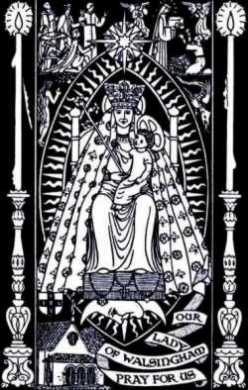 St Michaels, Kirkby Malham, box pews. This is a quintessentially English sight and one which warms my soul and makes me think thoughts of Mattins rather than High Mass and cricket on the lawns. And I was only away for a week! Don't worry, I'm going to Walsingham next week, normal service will resume soon.
St Michaels, Kirkby Malham, box pews. This is a quintessentially English sight and one which warms my soul and makes me think thoughts of Mattins rather than High Mass and cricket on the lawns. And I was only away for a week! Don't worry, I'm going to Walsingham next week, normal service will resume soon. 

Lovely old box pews for the upper classes at St Michael. Must as I disapprove of the system, the look is rather beautiful.

One of the great things about Anglican Churches as opposed to RC ones, is the charming domesticity of some of the architecture. Here is clearly a dignified corner of the Sanctuary of St Michaels, but it is also homely, as though the Vicar could snooze off in the dappled light after compline and dream dreams.
 Stunning East window at St Michaels.
Stunning East window at St Michaels.

The High Altar, Bolton Abbey Church.
The Anglican Monasteries are beginning to do well again and our convents (especially the traditional ones) and booming, thank God.

St Andrew's, Gargrave.

The organ pipes, Gargrave.
One of the joys of the Dales (where I shall soon, hopefully, be returning), is that of visiting country churches. It is so refreshing to find open churches and friendly people to guide you around and answer questions. It is also wonderful how well preserved, and authentically Anglican, the buildings themselves are. Here, though, is something which is not being preserved, the Yorkshire Dialect, in another poem by John Castillo, the Bard of the Dales. It evokes another time and a slower way of life, for of course, many of these fine old churches are now run by men who maybe have four or five churches to minister to and a lot more to do than before. Sometimes, it does us all good to slow down and remember times when people lived shorter lives and did less in them, by our increasingly fraught standards.
The Lucky Dream. John Castillo (1792-1845)
Ya Kessmas neet, or then aboot,
When measons all were frozzen oot,
I went to see a country friend,
An hospitable hoor to spend.
For gains, I cut across o' t' moor,
Whoor t' snaw sea furiously did stoor.
The hoose I gain'd an' enter'd in,
An' were as welcome as a king.
The storm agean t' windey patter'd,
An' hail-steans doon t' chimley clatter'd.
All hands were in, an' seem'd content,
An' nean did frost or snaw lament.
T' lasses all were at their sewing,
Their cheeks wiv health an' beauty glowing.
Aroond the hearth, in cheerful chat,
Twea or three friendly neighbours sat,
Their travels telling,
whoor they'd been,
An' what they had beath heeard an' seen.
Till yan did us all mich amuse,
An' thus a story introduce.
"I recollect lang saan," says he,
"A story that were tell'd to me,
At seems sea strange i' this oor dayThat true or false I cannot say.
A man liv'd i' this neighbourhood,
Nea doot of reputation good,
An' lang taame strave wi' stiddy care,
To keep his hoosehod i' repair.
At length he had a curious dream,
For three neets runnin' 't were the seame,
At if on Lunnon Brig he stood,
He'd hear some news would dea him good,
He labour'd hard, beath neet an' day,
Tryin' to draave those thowts away;
Yet daily grew mair discontent Till he at last to Lunnon went.
Being quite a stranger to that toon.
(one assumes he met a sticky end!)





_Black_s_s_s_s_s.jpg)
